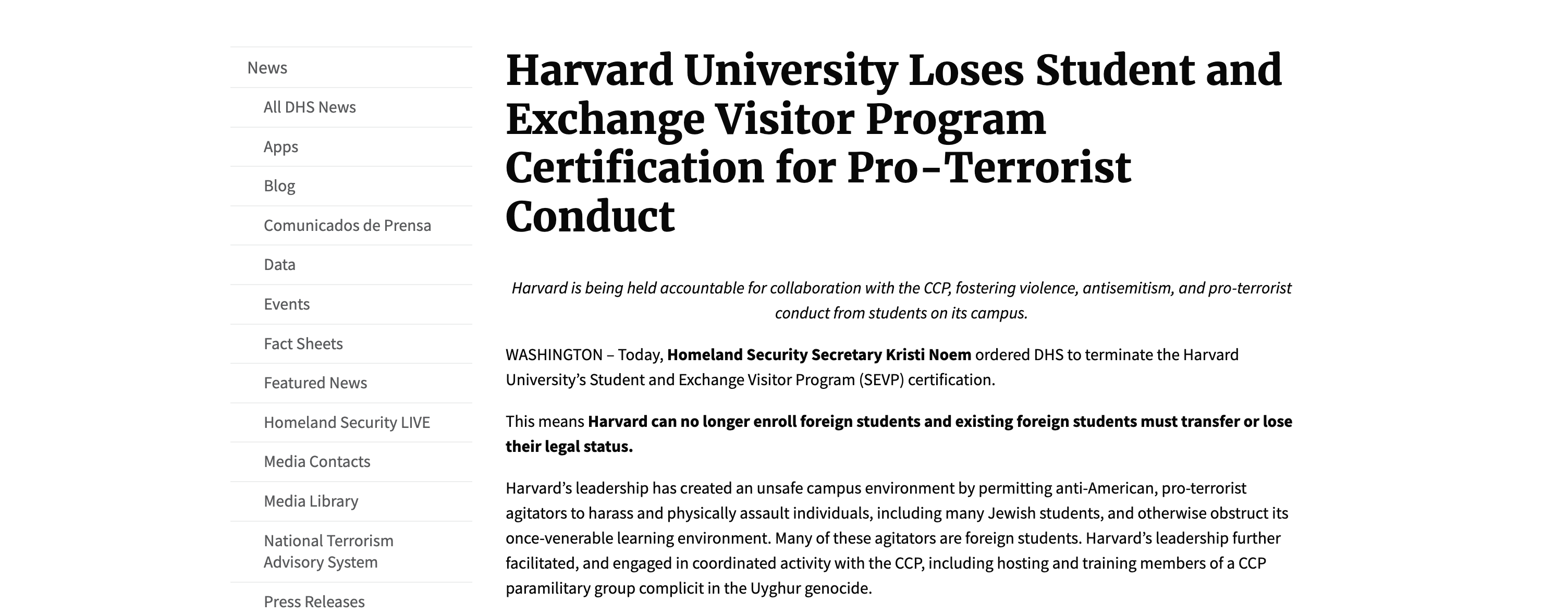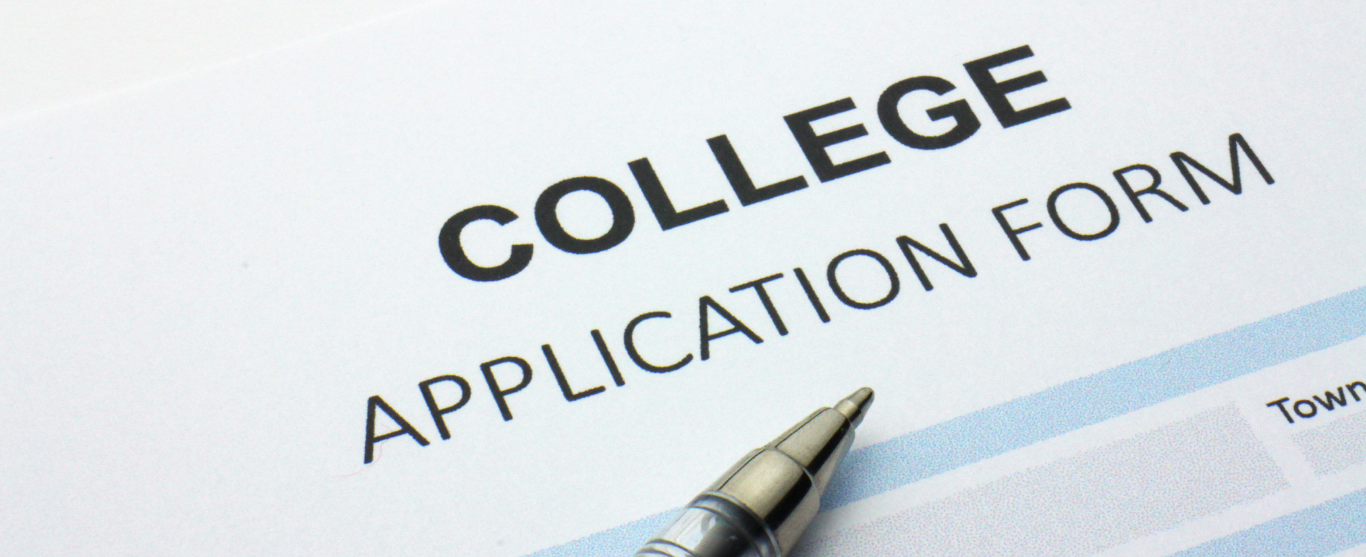Harvard International Students Got Banned: A Comprehensive Overview
目录
Trump Administration Notice
On May 22, 2025, the Trump administration made a sweeping move that stunned the academic world: Harvard University was stripped of its ability to enroll international students for the 2025–2026 academic year. This unprecedented decision, issued by the U.S. Department of Homeland Security (DHS), revoked Harvard’s SEVP (Student and Exchange Visitor Program) certification, effectively barring it from issuing new F-1 or J-1 visas and requiring current Harvard international students to transfer or leave the U.S. or risk falling out of legal immigration status.

Why banned Harvard international students?
Official Justification from DHS
In its official statement (source: DHS.gov), DHS cited the following reasons for revocation:
Noncompliance with SEVP Reporting Requirements: Harvard allegedly failed to submit adequate records of international students involved in pro-Palestinian campus protests.
National Security Concerns: Officials claimed the university had “longstanding relationships with China–affiliated organizations,” though they provided no public evidence.
Antisemitism Allegations: DHS accused Harvard of fostering a hostile environment by inadequately addressing antisemitic incidents on campus.
These accusations were issued following an expedited audit and “national security review” that Harvard claims it was never given a chance to respond to.
Fallout and Legal Battle
Harvard’s administration responded swiftly and forcefully. President Alan Garber called the decision “arbitrary, unlawful, and politically motivated,” confirming that the university had filed an injunction request in federal court to halt the enforcement. According to a report by AP News, over 6,800 Harvard international students currently enrolled are at risk of deportation or forced transfer by mid-August if no legal relief is granted.
As noted in Reuters, this is the first time in modern U.S. history that a top-tier research university has lost SEVP certification, raising alarm across the academic community and setting off a wave of uncertainty at other elite institutions with large international populations.
Harvard’s Global Reach: A Disrupted Pipeline
For decades, Harvard has served as a global magnet for top-tier students from around the world—particularly from countries such as China, India, South Korea, and beyond. According to Harvard’s own Office of Institutional Research, international students made up more than 23% of the undergraduate population as of 2024. These students don’t just contribute tuition revenue—they inject intellectual vitality, cross-cultural dialogue, and research excellence into the Harvard ecosystem.
But the DHS ruling in May 2025 abruptly halts this flow. Without the ability to issue F-1 or J-1 visas, Harvard has lost its legal authority to admit or retain international students. The effects go far beyond logistics—this policy fundamentally alters Harvard’s demographic, academic, and financial structure, and may trigger ripple effects across the Ivy League and the U.S. higher education system at large.

Why This Matters for U.S. and Asian American Families
While the immediate consequences fall on international students, U.S.-based applicants—particularly Asian American families—are entering uncharted territory as a result of this policy. Here’s why it matters:
Less international competition? On paper, removing thousands of high-performing global applicants could improve domestic students’ odds of admission. Harvard has historically been flooded with top applicants from abroad, many scoring near-perfect grades and test scores. Their absence could mean a temporary boost in admission chances for U.S. citizens, particularly in STEM and business majors where international representation is highest.
More unpredictability, not less. However, this may not lead to easier admissions. Instead, elite schools could become even more selective in other ways—by giving greater weight to legacy, development (donor influence), or political considerations as they face mounting media and legal pressure. The result may be increased volatility and shifting priorities in how applicants are evaluated.
Asian American students face a double-edged sword. Asian Americans have long walked a tightrope in elite college admissions—performing at the top academically, but under the weight of unspoken quotas and “personality score” controversies (as highlighted in the 2023 Supreme Court ruling). With international Asians now largely removed from the pool, domestic Asian American applicants may either benefit from less statistical competition—or become even more scrutinized as Harvard reshuffles its balance.
In other words: this isn’t a guaranteed win for any one group. It’s a destabilization—one that reshapes the competitive landscape in unpredictable ways.
Broader Trends: Admission Rates Are Crashing
The Harvard international student ban comes amid a broader, more alarming reality: getting into top U.S. universities has never been harder.
According to longitudinal admissions data compiled by IvyMax and publicly available sources, nearly every elite university has seen a dramatic drop in admit rates over the last decade. The table below highlights how admission has tightened by up to 50% at some schools, including Harvard, Stanford, and UCLA:
| University | 2015 Admit Rate | 2025 Admit Rate | % Change |
|---|---|---|---|
| 哈佛大学 | 5.3% | 3.4% | -36% |
| 斯坦福大学 | 7.1% | 3.6% | -49% |
| 麻省理工学院(MIT) | 7.9% | 4.5% | -43% |
| 加州大学洛杉矶分校 | 18% | 9% | -50% |
| Michigan | 26% | 17.9% | -31% |
(Source: IvyMax Research Team / Public Admission Stats)
What’s Driving the Decline?
- Application surges: The adoption of the Common App and UC-wide platforms has made it easier than ever to apply to multiple schools. Harvard alone received over 57,000 applications in 2024.
Test-optional policies: Post-2020 test-optional movements have increased application volume by lowering the barrier to apply—especially for students from non-traditional or under-resourced backgrounds.
Demographic shifts: More international and out-of-state students are seeking U.S. degrees, and public flagships like UCLA and Michigan are becoming more popular alternatives to private Ivies.
In this environment, even “safety schools” are no longer safe. And now, Harvard’s enrollment upheaval is about to add new chaos to the mix.
Implications for U.S. College Admissions in 2025
The Harvard ban isn’t just a policy anomaly—it’s a signal of the new geopolitical, legal, and demographic forces reshaping the American college admissions landscape. Here’s how these forces are likely to affect both international and U.S.-based students.
Impact on Domestic Applicants
At first glance, domestic students may seem to benefit. But the landscape is more complicated.
✅ Potential Benefits:
Less global competition: With fewer international high achievers applying, the admissions pool may slightly open—particularly in STEM majors and full-pay slots where international students once dominated.
More room for U.S.-based diversity: Institutions may respond by increasing seats for underrepresented domestic populations, including first-gen and rural students.
⚠️ Rising Challenges:
Increased selectivity: To maintain prestige, universities may become even more conservative and selective in admitting students from overrepresented groups—such as high-scoring Asian Americans.
Shift in review criteria: Expect more weight placed on holistic attributes like leadership, hardship narratives, and community impact, rather than test scores alone.
As a result, families must now navigate a paradox: there may be fewer competitors, but the rules of engagement are shifting—and the margin for error is thinner than ever.

Trends in U.S. College Admissions: 2025 and Beyond
The landscape of college admissions is not just evolving—it’s undergoing a structural transformation. The Harvard international student ban may be the catalyst, but it rides on the back of deeper admissions currents already reshaping the pipeline for both domestic and international applicants.
From Global to Local Focus
As elite institutions face mounting pressure from U.S. political leadership, alumni, and public scrutiny, many are shifting focus back toward domestic applicants—especially first-generation students, low-income households, and minority groups. The implication? Students from well-resourced backgrounds, including high-achieving Asian American applicants, may face tighter lanes into top universities.
Admissions as Politics
Admissions decisions are becoming deeply entangled with public policy. Whether it’s affirmative action rollbacks, donor influence investigations, or geopolitical flashpoints like the Harvard-international student ban, elite institutions are operating in a charged environment. Admissions offices are navigating public optics, donor expectations, and political pressure more than ever before.
This adds unpredictability—even for applicants with near-perfect profiles.
The Rise of 'Soft Signal' Evaluation
Traditional metrics (GPA, test scores) remain important—but they’re no longer sufficient. Increasingly, admissions teams are trained to identify “soft signals” that indicate resilience, leadership, or social contribution. These might include:
Community impact and volunteerism
Independent research or entrepreneurial ventures
Creative or multicultural storytelling in essays
The message to families: academic perfection without human depth is no longer enough.
Consolidation of Application Platforms
The Common App, UC App, and Coalition App continue to dominate the landscape, leading to a surge in application inflation. Students now apply to 15–20 schools on average. This is making admissions data misleading—more applicants, but no more spots.
Expect schools to introduce more filters (e.g. supplemental essays, portfolio uploads) to differentiate serious candidates from volume-based applicants.
Strategic Considerations for Applicants
In this volatile environment, applicants can no longer afford passive or last-minute strategies. The families that succeed in 2025 and beyond are those who prepare early, adapt quickly, and personalize every aspect of their application journey.
Here’s what smart planning now looks like:
1. Start Planning in 9th Grade
Given how selective the landscape has become, building a compelling application starts years in advance. Top students are now:
Enrolling in college-level coursework through dual enrollment or AP programs
Engaging in guided research or innovation programs (especially STEM, AI, sustainability)
Documenting impact—from awards to leadership to initiative
IvyMax students typically begin roadmap planning before junior year to avoid last-minute panic.
2. Go Beyond GPA & Test Scores
Admissions readers want to know: “What will this student add to campus life?” That means:
Essays that are reflective and personal, not formulaic
Activities that demonstrate initiative, not just participation
Strong letters of recommendation that tell stories, not just stats
3. Target the Right Schools With Real Strategy
Ranking doesn’t always equal fit. Students need to understand:
Which schools prioritize demonstrated interest
Where their profile aligns with admissions priorities (e.g., underrepresented major, regional diversity)
💡 At IvyMax, our counselors break down institutional priorities and align student profiles with schools most likely to value them—maximizing both reach and safety outcomes.
4. Avoid Common Pitfalls
Overreliance on rankings
Ignoring school-specific essay prompts
Failing to show authentic character development
Copy-paste extracurriculars across all apps
Assuming a “perfect score” guarantees success
What Should International Students Do?
For many international students, especially those who once aspired to attend Harvard or other top-tier U.S. institutions, the recent ban is more than a policy shift—it’s a personal disruption. But while Harvard’s SEVP decertification is a serious setback, it does not mark the end of the road.
Here’s what international students should do in response:
1. Understand the Scope of the Ban
The Department of Homeland Security has specifically revoked Harvard University’s SEVP certification, meaning the school can no longer issue I-20 forms required for F-1 visas. This ban does not extend to other universities, but it does signal heightened federal scrutiny across elite institutions.
2. Diversify Your U.S. School List
While Harvard may no longer be an option in the near term, other top-ranked U.S. universities remain open to international applicants. Students should:
Consider schools with strong global research reputations
Check visa and international support policies on school websites
Prioritize institutions with high international student satisfaction and robust services
3. Stay Informed on Immigration Policy
Under the Trump administration, immigration policy is rapidly evolving. Students and families should:
Monitor updates from DHS, SEVP, and U.S. embassies
Work with certified educational consultants or school advisors
Avoid misinformation spread on social media or unofficial forums
Is the Ivy League Still Worth Applying To?
With elite admission rates falling to all-time lows—and policies like Harvard’s international student ban reshaping the landscape—it’s fair for students and parents to ask:
“Is it still worth aiming for the Ivy League?”
The answer is yes—but only if you approach it strategically.
The Ivy League continues to represent the highest tier of academic prestige and opportunity in the U.S. and abroad. Its alumni networks fuel global leadership in technology, law, medicine, finance, and public policy. But in 2025 and beyond, Ivy League applications are less about prestige chasing, and more about personal fit, clarity of goals, and tactical execution.
What Today’s Families Need to Know:
Ivy League schools are not one-size-fits-all: Yale values community impact, Princeton prizes focused intellectual pursuits, and Brown champions curiosity without structure. Understanding each school’s DNA is essential.
It’s not just about getting in—it’s about standing out: In a sea of perfect GPAs and 4.0s, schools are searching for voice, depth, and purpose. A compelling story matters more than 100 extracurriculars.
You need a plan, not just a dream: Families who succeed know how to research, prepare, and execute at every stage—from course selection and activities, to essays and letters of recommendation.
“The Ivy League hasn’t closed its doors. But it is only open to those who are prepared to enter through the right one.”
That’s why so many families turn to IvyMax.
In the 2025 cycle alone, IvyMax students achieved extraordinary results:
5 students admitted to Harvard
8 students admitted to Stanford
10 students admitted to Cornell
These aren’t outcomes based on luck. They’re the product of rigorous academic planning, essay strategy, and storytelling coaching designed to match each student with the school where they belong—and can thrive.
If the Ivy League is still your family’s aspiration, it’s not out of reach. But you need to play the admissions game with the right tools, timing, and guidance.
* This situation remains fluid, and the future for Harvard international students is still unfolding as legal challenges and policy responses continue to develop.
提交表单即代表您同意接收 IvyMax 的最新资讯和课程信息。您可以随时通过邮件底部的 SafeUnsubscribe® 链接取消订阅。
对我们的项目感兴趣?
请填写表单,我们会尽快回复您,并提供详细信息,解答您的问题!

